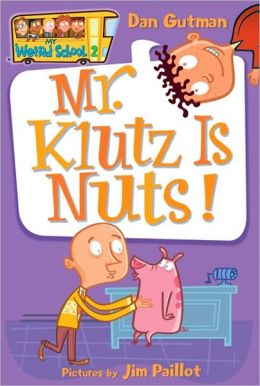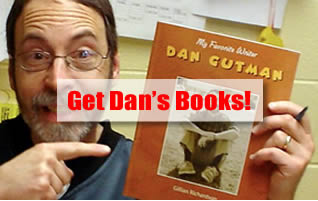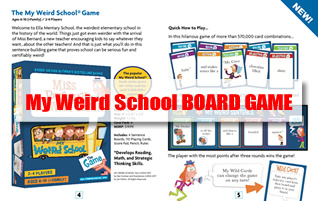My Weird School Classroom Activity Sheet
CLICK here to download a pdf version.
By Dan Gutman
Illustrated by Jim Paillot
Ages 7–10 • Grades 2–5
 Publisher: HarperCollins, 2004 My Weird School #1: |
 Publisher: HarperCollins, 2004 My Weird School #2: |
His teacher doesn’t know how to read or write. His principal is always pulling wacky stunts. For second grader A.J., school is one peculiar place. Young readers will find the first two stories in Dan Gutman’s hilarious new My Weird School series—Miss Daisy Is Crazy! and Mr. Klutz Is Nuts!—infectiously funny. Build on students’ enthusiasm and inspire further learning in math and language arts with this classroom activity sheet. But beware! Things could get really weird.
About the Author
Dan Gutman has written numerous books for children, including five Baseball Card Adventures: Honus & Me, Jackie & Me, Babe & Me, Shoeless Joe & Me, and Mickey & Me. When he is not writing, Dan likes to visit schools, many of which are quite strange. Dan lives in New Jersey with his wacky wife, Nina, and their two wild children, Sam and Emma.
About the Artist
Jim Paillot’s comical illustrations have appeared in books, magazines, newspapers, and advertisements nationwide. He recently moved with his wife and two kids, Cam and Rosie, to Arizona, where they are getting used to the very unusual idea of wearing shorts in the middle of winter.
School Rules?
Kids should not have to go to school, says A.J. In fact, he believes children can learn all they need to know by watching television. Do your students think children should have to go to school? Discuss the issue as a class. Have students write you a letter presenting their case for or against school. Survey the class before they start writing to see where they stand. Read letters aloud the following day. Did any of the letters present arguments that made students change their opinion? What made them reconsider their position?
Book It!
Miss Daisy doesn’t understand arithmetic. “I don’t even know what you get if you multiply four times four,” she says (Miss Daisy Is Crazy!, p.8). One of her students explains multiplication to her by lining up four rows of four pencils each. Have your class create mini math booklets explaining arithmetic to Miss Daisy. Give each student two sheets of 81/2 x 11–inch paper to fold and cut into four equal pieces, put together, and staple along the side to create a booklet. Write multiplication equations on the board. Have students select seven to fourteen equations, and ask them to write one per page along with an illustration showing how they would use an example to explain each equation to Miss Daisy.
Cast a Spell
Miss Daisy asks each student to write on the board three words that they know how to spell (Miss Daisy Is Crazy!, p.24). Mr. Klutz challenges everyone in the school to come up with a list of 100,000 spelling words by Thanksgiving (Mr. Klutz Is Nuts!, p.72). Issue a similar challenge. Create a class list of words students know how to spell. Write them on the board first, then copy the list onto chart paper. Display for future reference. Initiate a school—wide challenge by having other classrooms participate. See how many words your school knows how to spell. Interested students might also wish to take part in a school spelling bee.
School of Dreams
A.J. and his friends decide the only way to make school more fun is to buy the building (Miss Daisy Is Crazy!, chapter 5). Discuss the students’ plan. What subjects will they teach? What rules will they enforce? Have students create a plan for their own dream school. Brainstorm a list of changes students would make. Then have students select one area on which to focus. Have students work individually or in groups to create written and visual examples explaining their dream school. For example, a student or group in charge of revamping the cafeteria might develop a menu as well as a floor plan for the seats and tables. When the plans are completed, have students share them with the class.
Measuring Up
The school nurse not only measures the students’ height and weight, she measures the length of her own foot and the circumference of her head (Miss Daisy Is Crazy!, chapter 5). Have your students take their own measurements.
Distribute sewing tape measures to pairs of students. Have them measure each other’s height, feet, and head and record the data on personalized index cards. As a companion activity, have students create life-sized self portraits. Give each student a large sheet of butcher paper. Students should place the paper on the floor, then lay down on top of it while their partner traces their body with chalk. Have them fill in the details with tempera paint or mixed media, cut out the images when dry, and display them in size order. Post children’s measurements next to each image. Update the measurements each month.
Say What?
A.J. learns a lesson about the importance of education when Miss Daisy invites a professional football player to speak to the class (Miss Daisy Is Crazy!, chapter 10). Invite adults to your class—or school— to speak about their careers and how school played a part in their success. Before the visit, have students brainstorm a list of questions. As an alternative, have students interview an adult of their choosing. They should come up with questions and create an interview sheet. Have students report back to the class about what they learned. Older students may wish to turn their interviews into newspaper or magazine articles. Compile the articles—along with photos or illustrations of the people interviewed—in a class publication.
Keeping Score
A.J. wants to be a professional athlete when he grows up, and Miss Daisy uses this information to sneak mathematical questions into their conversations. Use your students’ interest in sports to do the same. During basketball season, for example, ask mathematical equations based on the game, such as: “If a basket is worth two points and Player A made five baskets, how many points did he or she score?” Have students create their own sports-based math problems.
Rock the Vote
Mr. Klutz tells students he will climb the flagpole and recite the Pledge of Allegiance if, by election day, they write essays about “what it means to have elections” (Mr. Klutz Is Nuts!, p.62). Demonstrate the importance of voting by staging mock elections. Tally votes. Figure out what fraction or percentage of the class voted for or against the issue or candidate. Have students use the school library and the Internet to research U.S. voting rights. Who is eligible to vote? How have African-Americans and women struggled to secure the right to vote? Have older students research voting rights and the election process in other countries. Students should present their findings to the class.
Math Mania
Mr. Klutz promises the students a chocolate party if they do a million math problems (Mr. Klutz Is Nuts!, p.40). Suddenly, teachers pose math questions in every class. During the library period, for example, Mrs. Roopy asks, “If the library had a hundred books and you checked out fifty of them, how many would be left in the library?” (p.56). Challenge students to come up with and solve math problems based on real-life situations. As a class, keep track of the number of math problems completed each day. Reward students’ efforts with a special activity.
Write On!
It’s hard to imagine a teacher crazier than Miss Daisy or a principal nuttier than Mr. Klutz. Invite your students to give it a try anyway! Have students write stories based on the My Weird School series. What loony things would the teachers do to make learning fun? What wacky stunts might the principal pull to motivate students? Have students brainstorm a list of silly scenarios before writing stories about them. Students should share stories in small groups and make revisions based on classmates’ feedback. Have students illustrate their stories and design catchy covers. Celebrate students’ work with a publishing party.
My Weird Math!
See if you can solve these problems…
- Ms. Todd was odd for 60 days one year and 80 days the next year. How many days was she odd in all?
- Mr. Macky had 200 cans of soup. He sat down and read the labels of 125 of them. How many more labels does he have to read?
- A.J. ate 100 candy bars a month. How many candy bars did he eat in 5 months?
- Andrea juggled 81 apples, and she dropped 79 apples. How many apples is she juggling now?
- Mrs. Yonkers turned 57 bunches of broccoli into 57 lollipops with her Junk Food Transformer. A.J., Andrea, Emily, Ryan, and Michael each ate 10 of the lollipops. How many lollipops are left for Neil the nude kid?
- Mr. Klutz kissed 15 pigs. He earned $11 per kiss. How much money did he earn?
- A.J. brought 50 pieces of gum to school with him, which he shared with Ryan, Michael, and Neil the nude kid. How much candy did each student get?
- One day Mrs. Roopy got so loopy that she stayed home for the next 19 days. If there were 180 days of school, how many days was she there?
- Mrs. Kormel was not normal for 4 days one week. She was not normal for 3 days the next week. How many days was she not normal?
- Miss LaGrange got paid $100 on Monday, and she bought some cook books for $75 on Tuesday. How much money does she have left?
- Mr. Hynde has 40 rap songs and 20 rock songs on his iPod. How many songs does he have in all?
- Miss Small threw a ball at a wall 109 times one day and 200 times the next day. How many times did she throw a ball at the wall?
- Miss Daisy ate 52 bon bons on Friday night, and then she ate 29 bon bons on Saturday night. How many bon bons did she eat over the weekend?
- One year Mr. Klutz was nuts for 55 days. The next year he was nuts for 49 days. How many days was he nuts in all?
- Mr. Docker put 739 potatoes in his potato powered car, and he needs 1,000 potatoes to run it. How many more potatoes does he need?
- Miss Lazar cleaned 27 toilets on Friday and she cleaned 16 toilets on Saturday. How many toilets did she clean in all?
- Dr. Carbles had 973 marbles. He lost 782 of them. How many marbles did Dr. Carbles lose?
- Ms. Coco earned $250 in 2006 and $897 in 2007. How much money did she earn?
- Mr. Louie had $57 and Miss Holly had $72. What’s the difference?
- Ms. Hannah bought 73 bananas and each banana cost $1. Then she bought 2 apples, which cost $2.50 each. How much money did she spend?
- Mrs. Patty had $5. A.J. had $3 and Ryan had $7. If the boys put their money together, how much more will they have than Mrs. Patty?
The answers: How should I know? YOU figure ‘em out! So nah nah nah boo boo! Thanks to the 3rd grade kids at Lincoln School, in Wyckoff, New Jersey, who made up these problems.
Download A Teaching Guide: The Weird Word of Dan Gutman (PDF-file)






